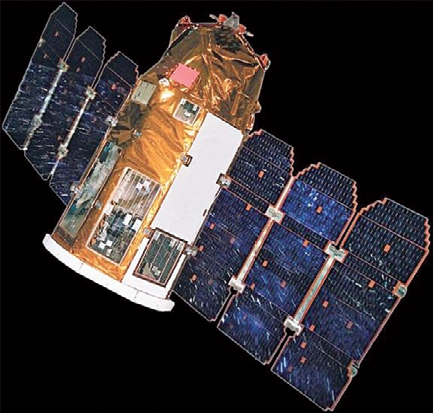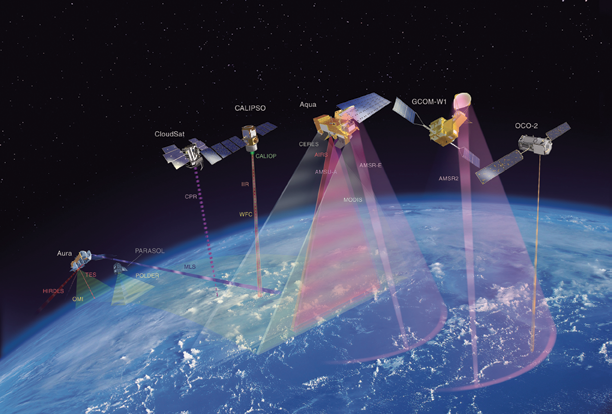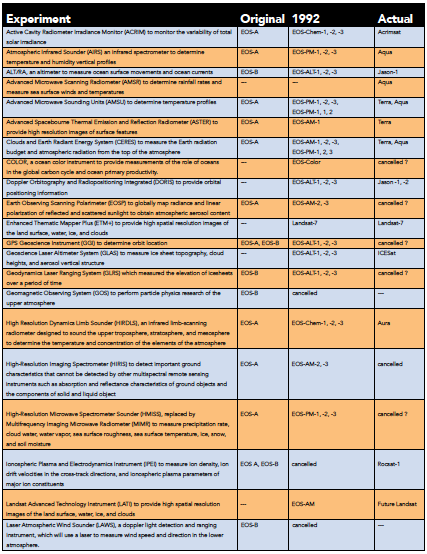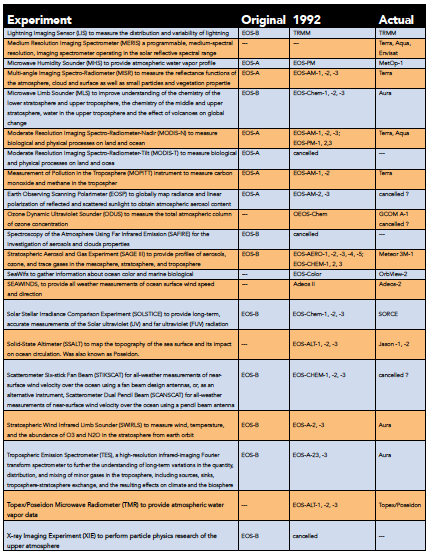The Earth Observing System (EOS) was the principal element of NASA’s Mission to Planet Earth (MTPE) program that can be traced back to the 1960s when the study of Earth was considered an appropriate effort for the international community.

Artistic rendition of the EOS-B satellite. Image is courtesy of Imagesat International.
EOS was conceived as a program to understand Earth systems via a broad range of environmental and Earth science measurements, all from the vantage point of space. The goal was to measure as many of the variables of interest to Earth scientists as was possible.
An observation period of 15 years was considered appropriate as that time frame would include a complete sunspot cycle as well as several El Niño events and perhaps even the eruption of one or more major volcanoes.
Planning for the EOS missions started in the early 1980s and, at that time, NASA planned to make extensive use of satellites in Low Earth polar orbit, which would be serviced by Space Shuttle launches from Vandenberg Air Force Base (VAFB) in California in order to maintain and change instruments.
The connection with the Space Station ended after the Challenger accident when NASA terminated plans to launch the Space Shuttle into polar orbit, although the idea of large platforms remained.
This led to the EOS-A and EOS-B series spacecraft as well as payloads designed to be attached to the proposed Freedom Space Station. Some instruments were also earmarked for the proposed Japanese and European polar-orbiting satellites, then referred to as the Japanese Polar-Orbiting Platform (JPOP) and the European Polar-Orbiting Platform (EPOP).
The initial EOS, as devised in 1989, was to consist of two 15,000 kg. satellites that would have been launched by a Titan IV (with Solid Rocket Motor Upgrades (SRMU’s) rocket, launched from VAFB.
EOS-A and –B would have carried a range of instruments. EOS-A1 was scheduled for a 1998 launch, while EOS-B1 was scheduled for launch in 2001.
Similarly instrumented satellites, EOS-A2 and –A3, as well as EOS-B2 and –B3, were to be launched at two to three year intervals. With an operational life of five years for each satellite, this would have covered the desired 15- year mission timeframe.
Following an Announcement of Opportunity in 1988, 458 proposals for instruments were received from the scientific community. Eventually, NASA selected 29 instruments.

Artistic rendition of the “A-Train.”
1992 Revision
In 1992 the original EOS plans were modified for three reasons:
• A new focus of EOS objectives towards the problem of global climate change
• A move towards flying the instruments on multiple smaller platforms, rather than a series of large observatories
• A reduction in budget from US$17 to US$11 billion through FY2000
By 1992 this evolved into a revised program consisting of:
• The EOS-AM series of three satellites were to be polar orbiting crossing the equator at 10.30 a.m. local time to characterize the radiation balance of terrestrial surfaces, clouds and aerosols. The satellites were to be built by Lockheed Martin and scheduled for launch in 1998, 2003 and 2008
• The EOS-PM series of three satellites were to cross the equator at 1.30 p.m. local time to study clouds, precipitation and radiative balance, terrestrial snow and ice, sea surface temperatures as well as ocean productivity. The satellites were to be built by TRW and were to be launched in 2000, 2005 and 2010
• The EOSChem series of three satellites were to be built by TRW to investigate atmospheric chemicals and their transformations as well as ocean surface stress. The planned launch dates were 2002, 2007 and 2012
• EOSColor, a single satellite was to be launched in 1998 into a sun-synchronous polar orbit to study the biomass and the productivity of aerosols

• EOSAero series of five satellites to be launched in 2000, 2003, 2006, 2009 and 2012 were scheduled to be launched into an orbit with an inclination of 57 degrees and would have studied atmospheric aerosols
• EOSAltimetry series of three satellites to be launched in 2002, 2007 and 2012 were scheduled to be launched into a sun-synchronous polar orbit to study ocean circulation and ice sheet mass balance
A number of the instruments planned for EOS-A and –B found their way to these satellites. Other instruments that were part of the original EOS plan were dropped, placed on other satellites, or simply replaced by newer instruments.
Gradually, plans were further modified and, by 1995, the program was reduced to three series of satellite missions, as well as several smaller missions and joint missions with other countries. Under the baseline plan, as many as 36 spacecraft would carry 80 instruments, of which NASA would provide 21 spacecraft and 65 instruments.
1998 Revision
Over the years, the budget was further reduced to US$8 billion—EOS began to rely more and more on the international partners. By June of 1998, NASA’s EOS program consisted of just three satellites:
• EOS-AM-1, which was launched as Terra Earth on December 18, 1999
• EOS-PM-1, which was launched as Aqua on May 4, 2002
• EOSChem-1, which was launched as Aura on July 14, 2004
Two of these three satellites are currently part of the A Train, a system that was to consist of six polar orbiting satellites that traveled in line mere minutes apart. Their overlapping science instruments give a comprehensive picture of Earth weather and climate.
The “A” in the A-Train is for “afternoon” as the lead satellite, Aqua, crosses the equator at the mean local time of approximately 1:30 p.m. The satellites are, in flight order:

• Aqua, launched on May 4, 2002
• CloudSat, launched on April 28, 2006
• CALIPSO, a French satellite launched on April 28, 2006
• PARASOL, French satellite launched on December 18, 2004
• Aura, launched on July 14, 2004
• Glory, launched on March 4, 2011 which failed to gain orbit
OCO, launched on February 24, 2009, was to be part of the A Train but also failed to gain orbit.
The A Train
Other satellites that picked up EOS instruments included:
• TRMM, launched on November 27,1997
• Rocsat-1, launched on January 27, 1999
• Landsat-7, launched on April 15, 1999
• Acrimsat, launched on December 21, 1999
• EO-1, launched on November 21, 2000
• Meteor 3M-1, launched on December 10, 2001
• Jason-1 and -2, launched on December 7, 2001 and June 29, 2008, respectively
• Envisat, launched on March 1, 2002
• ADEOS-2, launched on December 14, 2002
• ICESAT, launched on January 13, 2003
• SORCE, launched on January 25, 2003
• MetOp-1, launched on October 19, 2006
As indicated above, out of the 458 instrument proposals received in 1988, 29 were selected for further development as payloads on the EOS-A and –B satellites. As the program was modified, as outlined above, several of these instruments were carried forward and some were eventually launched, while others were completely dropped from the program.

The tables, above right, provide an overview that is based on information that could be gathered from currently available sources.
About the author
Jos Heyman is the Managing Director of Tiros Space Information, a Western Australian consultancy specializing in the dissemination of information on the scientific exploration and commercial application of space for use by educational as well as commercial organisations. An accountant by profession, Jos is the editor of the TSI News Bulletin and is also a regular contributor to the British Interplanetary Society’s Spaceflight journal. Jos is also a Senior Contributor for SatMagazine

